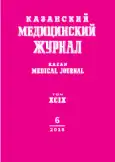Токсическое влияние наночастиц диоксида титана на морфологические характеристики тимуса
- Авторы: Шарафутдинова Л.А.1, Синельников К.Н.1, Валиуллин В.В.2
-
Учреждения:
- Башкирский государственный университет
- Казанский государственный медицинский университет
- Выпуск: Том 99, № 6 (2018)
- Страницы: 947-953
- Тип: Экспериментальная медицина
- URL: https://ogarev-online.ru/kazanmedj/article/view/10511
- DOI: https://doi.org/10.17816/KMJ2018-947
- ID: 10511
Цитировать
Полный текст
Аннотация
Цель. Изучение влияния наночастиц диоксида титана при их пероральном введении на морфофункциональное состояние вилочковой железы крыс.
Методы. В данной работе с использованием классических морфологических подходов и специфичных маркеров: пролиферации - Ki-67, апоптоза - белка p53 и макрофагов - CD68, позволяющих адекватно идентифицировать не только сами клетки, но и их функциональное состояние, проведено исследование тимуса крыс после перорального введения (10 мг/кг массы тела животного, 28 дней) нанодисперсной формы TiO2 (рутильная форма, 40-60 нм), полученной разведением порошка TiO2 в дистиллированной воде. Агрегацию наночастиц предотвращали обработкой суспензии нанодисперсного TiO2 в ультразвуковой ванне. Крысам контрольной группы перорально вводили дистиллированною воду в том же объеме. Серийные парафиновые срезы тимуса окрашивали гематоксилин-эозином, пикрофуксином по Ван Гизону, проводили иммуногистохимическое окрашивание с использованием антител к Ki-67, CD68, р53.
Результаты. Выявлены существенные изменения ткани вилочковой железы при воздействии НЧ TiO2. В тимусе экспериментальных животных установлено уменьшение доли коркового вещества на 17,6 %, отмечается значительное снижение плотности клеточной популяции за счет уменьшения количества тимоцитов. Иммуногистохимическое типирование позволило обнаружить, что в условиях воздействия НЧ TiO2 наблюдается снижение числа Ki-67-позитивных клеток в корковом веществе дольки вилочковой железы, что говорит об угнетении процессов пролиферации в этих условиях. На фоне воздействия НЧ TiO2 обнаружено увеличение в 5,18 раз количества клеток, вступающих в апоптоз в корковом веществе дольки тимуса опытной группы, о чем свидетельствуют результаты иммуногистохимического исследования экспрессии маркера апоптоза белка р53. Возможно, в качестве компенсаторного механизма происходит выраженное увеличение количества макрофагов, на что указывает повышение среднего числа CD68-иммунопозитивных клеток в корковом веществе тимуса опытной группы в 2,61, а в мозговом веществе - в 1,35 раз.
Вывод. Обнаруженные морфофункциональные изменения тимуса при пероральном введении наночастиц TiO2 свидетельствуют об их иммуносупрессивном действии.
Ключевые слова
Полный текст
Открыть статью на сайте журналаОб авторах
Люция Ахтямовна Шарафутдинова
Башкирский государственный университет
Автор, ответственный за переписку.
Email: sharafla@yandex.ru
г. Уфа, Россия
Кирилл Николаевич Синельников
Башкирский государственный университет
Email: sharafla@yandex.ru
г. Уфа, Россия
Виктор Владимирович Валиуллин
Казанский государственный медицинский университет
Email: sharafla@yandex.ru
г. Казань, Россия
Список литературы
- Karimipour M., Zirak Javanmard M., Ahmadi A., Jafari A. Oral administration of titanium dioxide nanoparticle through ovarian tissue alterations impairs mice embryonic development. J. Reprod. Biomed (Yazd). 2018; 16 (6): 397-404. doi: 10.29252/ijrm.16.6.397.
- Winkler H.C., Notter T.,Meyer U.,Naegeli H. Critical review of the safety assessment of titanium dioxide additives in food. J. Nanobiotechnology. 2018; 16: 51. doi: 10.1186/s12951-018-0376-8.
- Weir A., Westerhoff P., Fabricius L., Hristovski K., von Goetz N. Titanium dioxide nanoparticles in food and personal care products. Environ. Sci. Technol. 2012; 46: 2242-2250. doi: 10.1021/es204168d.
- Ковалева Н.Ю., Раевская Е.Г., Рощин А.В. Проблемы безопасности наноматериалов: нанобезопасность, нанотоксикология, наноинформатика. Химическая безопасность. 2017; 1 (2): 44-87. doi: 10.25514/CHS.2017.2.10982.
- Wang X., Reece S.P., Brown J.M. Immunotoxicological impact of engineered nanomaterial exposure: mechanisms of immune cell modulation. Toxicol. Mech. Methods. 2013; 23 (3): 168-177. doi: 10.3109/15376516.2012.757686.
- Van Loveren H., Vos J.G., De Waal E.J. Testing immunotoxicity of chemicals as a guide for testing approaches for pharmaceuticals. Drug Info. J. 1996; 30: 275-279. doi: 10.1177/009286159603000132.
- Hong F., Zhou Y., Zhou Y., Wang L. Immunotoxic effects of thymus in mice following exposure to nanoparticulate TiO2. Environ. Toxicol. 2017; 32 (10): 2234-2243. doi: 10.1002/tox.22439.
- Ngobili T.A., Daniele M.A. Nanoparticles and direct immunosuppression. Exp. Biol. Med. (Maywood). 2016; 241 (10): 1064-1073. doi: 10.1177/1535370216650053.
- Кварацхелия А.Г., Клочкова С.В., Никитюк Д.Б., Алексеева Н.Т. Морфологическая характеристика тимуса и селезенки при воздействии факторов различного происхождения. Журнал анатомии и гистопатологии. 2016; 5 (3): 77-83. doi: 10.18499/2225-7357-2016-5-3-77-83.
- Susan A. Elmore. Enhanced Histopathology of the Immune System: A Review and Update. Toxicol. Pathol. 2012; 40 (2): 148-156. doi: 10.1177/0192623311427571.
- Moon E.Y., Yi G.H., Kang J.S., Lim J.S., Kim H.M., Pyo S. An increase in mousetumorgrowth by an in vivo immunomodulating effect of titanium dioxide nanoparticles. J. Immunotoxicol. 2011; 8 (1): 56-67. DOI: 10.3109/ 1547691X.2010.543995.
- Dua Y., Liu J., Ma L., Li N., Liu H., Wang J., Zheng L., Liu C., Wang X., Zhao X., Yan J., Wang S., Wang H., Zhang X., Hang G.F. Toxicological characteristics of nanoparticulate anatasetitanium dioxide in mice. Biomaterials. 2010; 31: 894-899. DOI: 10.1016/ j.biomaterials.2009.10.003.
- Eom H.J., Choi J. P38 MAPK Activation, DNA Damage, Cell Cycle Arrest and Apoptosis As Mechanisms of Toxicity of Silver Nanoparticles in Jurkat T Cells.Environ. Sci. Technol. 2010; 44: 8337-8342. doi: 10.1021/es1020668.
- Fröhlich E. Cellular Targets and Mechanisms in the Cytotoxic Action of Non-biodegradable Engineered Nanoparticles. Curr. Drug. Metab. 2013. 14 (9): 976-988. doi: 10.2174/1389200211314090004.
- Liu Y., Gao Y., Liu Y., Li B., Chen C., Wu G. Oxidative stress and acute changes in murine brain tissues after nasal instillation of copper particles with different sizes. J. Nanosci. Nanotechnol. 2014; 14 (6): 4534-4540. doi: 10.1166/jnn.2014.8290.
- Park E., Yi J., Chung K. Oxidative stress and apoptosis induced by titanium dioxide nanoparticles in cultured BEAS-2B cells. Toxicol. Lett. 2008. 180: 222-229. doi: 10.1016/j.toxlet.2008.06.869.
Дополнительные файлы






